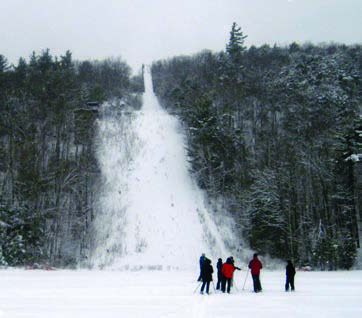Overbrthe years, the way ski jumps have been measured—and thus named—has changed. Forbrexample, the 60-meter jump at Gunstock is now called the 70-meter jump, althoughbrit’s really an 87-meter jump by international ski jumping standards.brbr
Beginningbrin 2004, the official size of a ski jump became based on its “hill size,” whichbris the distance from the take-off to the knoll at the top of the landing hillbrplus the length of the downhill portion of the landing hill. (Out-runs turn upbrat the end to help stop a jumper’s forward momentum.)
brbr
Forbrseveral decades prior to 2004, ski-jumping hills were named for theirbr“construction point,” known more commonly as the “K-point” or “critical point.”brThe K-point is at the steepest point (a 35-degree pitch) about two-thirds ofbrthe way down on the out-run, just before it begins to flatten out. Duringbrcompetition, it’s marked with a red line. The size of the jump was named forbrthe distance from the take-off point to the K-point. For example, if thebrdistance was 90 meters, then the jump was called a 90-meter jump.
brbr
DuringbrTorger Tokle’s era, jumping hills were measured from the take-off to “perfectbrpoint” or “P-point.” In the early days of ski jumping, athletes launched intobrthe air, stalled, and dropped. (Today jumpers are more like human airplanebrwings, riding on the “lift” created under their skis.) P-point was the designbrpoint in the hill that allowed for a comfortable, safe jump. If jumpersbrconsistently went farther than P-point, the start on the ramp was moved down,brand the competition started over.
brbr
Mostbrski jumps in the United States are still commonly named for their K-point. InbrGunstock’s case, the 70-meter jump was originally called a 60-meter jump basedbron its P-point. When it reopens, it will be a K-87 or 87-meter jump. Thebr10-meter jump is really a K-18 or 18-meter jump. The 20-meter jump is a K-26,brand the 40-meter jump is a K-50. Get the point?
BybrLisa Densmore Ballard


 View Print Edition
View Print Edition
I just had the three most amazing ski runs 40 inches of blower pow… in the white room